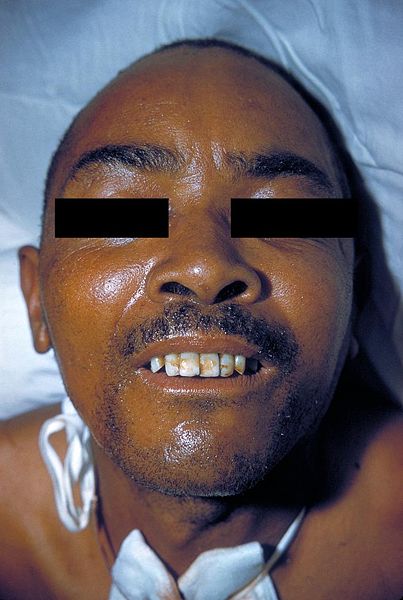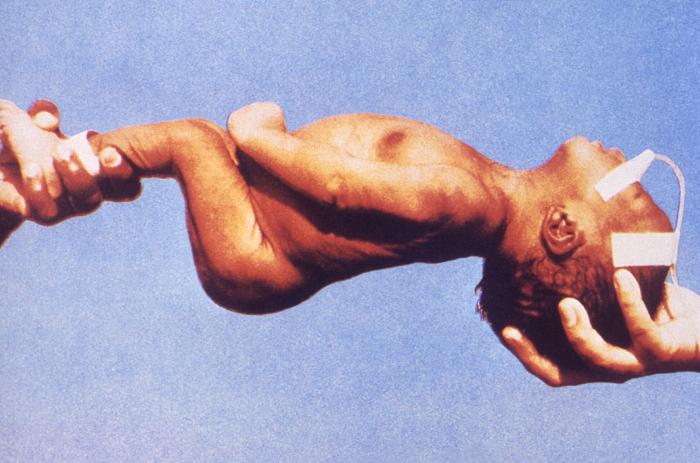Tetanus physical examination: Difference between revisions
Usama Talib (talk | contribs) |
Tarek Nafee (talk | contribs) |
||
| Line 5: | Line 5: | ||
==Overview== | ==Overview== | ||
Tetanus | Tetanus initially presents with [[muscle]] stiffness. The distribution may vary with the type of tetanus. [[Masseter muscle|The masseter muscles]] are commonly involved with an accompanying [[headache]]. [[Neck]] stiffness, difficulty [[swallowing]], generalized muscle [[spasms]] including the abdominal and back muscles and [[sweating]] may be seen later in the disease. In severe cases, respiratory paralysis may develop, which presents with [[apnea]], [[Hypoxemia|hypoxia]] and [[hypercapnia]]. | ||
==Physical Examination== | ==Physical Examination== | ||
Tetanus | Tetanus initially presents with [[muscle]] stiffness. The distribution may vary with the type of tetanus. [[Masseter muscle|The masseter muscles]] are commonly involved with an accompanying [[headache]]. [[Neck]] stiffness, difficulty [[swallowing]], generalized muscle [[spasms]] including the abdominal and back muscles and [[sweating]] may be seen later in the disease. In severe cases, respiratory paralysis may develop, which presents with [[apnea]], [[Hypoxemia|hypoxia]] and [[hypercapnia]]. Physical examination of a patient with tetanus may reveal the following:<ref>{{Cite journal | ||
| author = [[Mohamed Amirali Gulamhussein]], [[Yueyang Li]] & [[Abhijit Guha]] | | author = [[Mohamed Amirali Gulamhussein]], [[Yueyang Li]] & [[Abhijit Guha]] | ||
| title = Localized Tetanus in an Adult Patient: Case Report | | title = Localized Tetanus in an Adult Patient: Case Report | ||
| Line 42: | Line 42: | ||
===General Appearance=== | ===General Appearance=== | ||
*Severe muscular spasm ( | *Severe [[Muscle spasm|muscular spasm]] (location varies with the type) | ||
**[[Opisthotonos]] | **[[Opisthotonos]] | ||
**Leg [[extension]] with arm [[flexion]] | **Leg [[extension]] with arm [[flexion]] | ||
| Line 62: | Line 62: | ||
===Cardiovascular=== | ===Cardiovascular=== | ||
*S1 and S2 | *Normal [[Heart sounds|S1 and S2]] | ||
*[[Hypertension]] | |||
*[[Cardiac arrhythmia|Arrhythmia]] | |||
===Autonomic=== | ===Autonomic=== | ||
| Line 70: | Line 72: | ||
===Abdominal=== | ===Abdominal=== | ||
*Stiffening of the abdominal muscles | *Stiffening of the [[Muscles of the abdominal wall|abdominal muscles]] | ||
The physical examination may vary according to the type of tetanus. | The physical examination may vary according to the type of tetanus. Specific findings associated with the various types of tetanus may include: | ||
'''Local Tetanus''' | |||
**Limited area of spasm | **Limited area of [[spasm]] | ||
** | **The affected area is in close proximity to a contaminated wound | ||
**Contraction is usually [[painful]] and associated with [[swelling]] | **Contraction is usually [[painful]] and associated with [[swelling]] | ||
**Generalized tetanus may follow localized tetanus | **Generalized tetanus may follow localized tetanus | ||
'''Cephalic Tetanus'''<ref>{{Cite journal | |||
| author = [[L. Weinstein]] | | author = [[L. Weinstein]] | ||
| title = Tetanus | | title = Tetanus | ||
| Line 108: | Line 106: | ||
| pmid = 24052566 | | pmid = 24052566 | ||
}}</ref> | }}</ref> | ||
**[[Ear infection]] or [[head]] injury may be seen | **[[Ear infection]] or [[head]] injury may be seen | ||
**Trismus | **[[Trismus]] | ||
**Signs of [[Cranial nerves|CN III, IV, VI, VII and XII]] involvement including: | |||
**Signs of [[ | |||
***Tilting of the mouth | ***Tilting of the mouth | ||
***Inability to close the eye | ***Inability to close the eye | ||
** | ***Inability to move the tongue | ||
***Abnormal eye movements | ***[[Diplopia]] | ||
**Dysphagia | ***Abnormal eye movements | ||
** | **[[Dysphagia]] | ||
**[[Confusion]] | |||
**Symptoms of [[Ischemic stroke history and symptoms|stroke]] | |||
'''Generalized Tetanus''' | |||
**Descending [[spasm]] | |||
**Descending spasm | **[[Trismus]] may present initially | ||
**[[Trismus]] initially | ***Followed by [[Neck stiffness|stiffness of the neck]] | ||
***Followed by stiffness of the neck | |||
***Difficulty in [[swallowing]] | ***Difficulty in [[swallowing]] | ||
***Stiffness of [[abdominal muscles]] | ***Stiffness of [[abdominal muscles]] | ||
| Line 134: | Line 129: | ||
***Episodic rapid [[heart rate]] | ***Episodic rapid [[heart rate]] | ||
**[[Spasms]] may occur frequently and last for several minutes | **[[Spasms]] may occur frequently and last for several minutes | ||
**Spasms may continue for 3-4 weeks | **[[Spasms]] may continue for 3-4 weeks | ||
**Complete recovery may take months | **Complete recovery may take months | ||
'''Neonatal Tetanus'''<ref>{{Cite journal | |||
| author = [[Martha H. Roper]], [[Jos H. Vandelaer]] & [[Francois L. Gasse]] | | author = [[Martha H. Roper]], [[Jos H. Vandelaer]] & [[Francois L. Gasse]] | ||
| title = Maternal and neonatal tetanus | | title = Maternal and neonatal tetanus | ||
| Line 150: | Line 143: | ||
| pmid = 17854885 | | pmid = 17854885 | ||
}}</ref> | }}</ref> | ||
**Unhealed, unhygienic [[umbilical]] stump | **Unhealed, unhygienic [[umbilical]] stump | ||
**Trismus (spasm of masseter muscle) | **[[Trismus]] (spasm of [[masseter muscle]]) | ||
**Risus sardonicus (spasm of facial muscles) | **[[Risus sardonicus]] (spasm of facial muscles) | ||
**Clenched hands | **Clenched hands | ||
**Dorsiflexion of the feet | **[[Dorsiflexion]] of the feet | ||
**Opisthotonus (spasm of spinal muscles) | **[[Opisthotonus]] (spasm of spinal muscles) | ||
===The Spatula Test=== | ===The Spatula Test=== | ||
The "spatula test" is a clinical test for tetanus that involves touching the posterior pharyngeal wall with a sterile, soft-tipped instrument, and observing the effect. A positive test result is the contraction of the jaw (biting down on the "spatula"), and a negative test result would normally be a gag reflex attempting to expel the foreign object. | The "spatula test" is a clinical test for tetanus that involves touching the posterior pharyngeal wall with a sterile, soft-tipped instrument, and observing the effect. A positive test result is the contraction of the jaw (biting down on the "spatula"), and a negative test result would normally be a [[gag reflex]] attempting to expel the foreign object. | ||
[[Image:Lock-jaw 2857.jpg|thumb|center|150px|Lock-jaw in a patient suffering from tetanus.]] | [[Image:Lock-jaw 2857.jpg|thumb|center|150px|Lock-jaw in a patient suffering from tetanus.]] | ||
Revision as of 15:29, 27 June 2017
|
Tetanus Microchapters |
|
Diagnosis |
|---|
|
Treatment |
|
Case Studies |
|
Tetanus physical examination On the Web |
|
American Roentgen Ray Society Images of Tetanus physical examination |
|
Risk calculators and risk factors for Tetanus physical examination |
Editor-In-Chief: C. Michael Gibson, M.S., M.D. [1] Michael Maddaleni, B.S.; Associate Editor(s)-in-Chief: Usama Talib, BSc, MD [2]
Overview
Tetanus initially presents with muscle stiffness. The distribution may vary with the type of tetanus. The masseter muscles are commonly involved with an accompanying headache. Neck stiffness, difficulty swallowing, generalized muscle spasms including the abdominal and back muscles and sweating may be seen later in the disease. In severe cases, respiratory paralysis may develop, which presents with apnea, hypoxia and hypercapnia.
Physical Examination
Tetanus initially presents with muscle stiffness. The distribution may vary with the type of tetanus. The masseter muscles are commonly involved with an accompanying headache. Neck stiffness, difficulty swallowing, generalized muscle spasms including the abdominal and back muscles and sweating may be seen later in the disease. In severe cases, respiratory paralysis may develop, which presents with apnea, hypoxia and hypercapnia. Physical examination of a patient with tetanus may reveal the following:[1][2][3]
General Appearance
- Severe muscular spasm (location varies with the type)
- Opisthotonos
- Leg extension with arm flexion
- Risus sardonicus
- May be in respiratory distress
Vitals
- Fever
- Tachycardia
- Elevated blood pressure
Musculoskeletal
- Spasms of the diaphragm and intercostals
- Stiff abdominal wall
Respiratory
Cardiovascular
- Normal S1 and S2
- Hypertension
- Arrhythmia
Autonomic
- Intervals of
- Bradycardia and hypotension accompanied by of
- Tachycardia and hypertension
Abdominal
- Stiffening of the abdominal muscles
The physical examination may vary according to the type of tetanus. Specific findings associated with the various types of tetanus may include:
Local Tetanus
- Ear infection or head injury may be seen
- Trismus
- Signs of CN III, IV, VI, VII and XII involvement including:
- Tilting of the mouth
- Inability to close the eye
- Inability to move the tongue
- Diplopia
- Abnormal eye movements
- Dysphagia
- Confusion
- Symptoms of stroke
Generalized Tetanus
- Descending spasm
- Trismus may present initially
- Followed by stiffness of the neck
- Difficulty in swallowing
- Stiffness of abdominal muscles
- Other symptoms include
- Elevated temperature
- Sweating
- Elevated blood pressure
- Episodic rapid heart rate
- Spasms may occur frequently and last for several minutes
- Spasms may continue for 3-4 weeks
- Complete recovery may take months
Neonatal Tetanus[6]
- Unhealed, unhygienic umbilical stump
- Trismus (spasm of masseter muscle)
- Risus sardonicus (spasm of facial muscles)
- Clenched hands
- Dorsiflexion of the feet
- Opisthotonus (spasm of spinal muscles)
The Spatula Test
The "spatula test" is a clinical test for tetanus that involves touching the posterior pharyngeal wall with a sterile, soft-tipped instrument, and observing the effect. A positive test result is the contraction of the jaw (biting down on the "spatula"), and a negative test result would normally be a gag reflex attempting to expel the foreign object.


References
- ↑ Mohamed Amirali Gulamhussein, Yueyang Li & Abhijit Guha (2016). "Localized Tetanus in an Adult Patient: Case Report". Journal of orthopaedic case reports. 6 (4): 100–102. doi:10.13107/jocr.2250-0685.592. PMID 28164065. Unknown parameter
|month=ignored (help) - ↑ Yuki Kotani, Kenji Kubo, Satoko Otsu & Toshihide Tsujimoto (2017). "Cephalic tetanus as a differential diagnosis of facial nerve palsy". BMJ case reports. 2017. doi:10.1136/bcr-2016-216440. PMID 28108438. Unknown parameter
|month=ignored (help) - ↑ Anisha Doshi, Clare Warrell, Dima Dahdaleh & Dimitri Kullmann (2014). "Just a graze? Cephalic tetanus presenting as a stroke mimic". Practical neurology. 14 (1): 39–41. doi:10.1136/practneurol-2013-000541. PMID 24052566. Unknown parameter
|month=ignored (help) - ↑ L. Weinstein (1973). "Tetanus". The New England journal of medicine. 289 (24): 1293–1296. doi:10.1056/NEJM197312132892408. PMID 4270702. Unknown parameter
|month=ignored (help) - ↑ Anisha Doshi, Clare Warrell, Dima Dahdaleh & Dimitri Kullmann (2014). "Just a graze? Cephalic tetanus presenting as a stroke mimic". Practical neurology. 14 (1): 39–41. doi:10.1136/practneurol-2013-000541. PMID 24052566. Unknown parameter
|month=ignored (help) - ↑ Martha H. Roper, Jos H. Vandelaer & Francois L. Gasse (2007). "Maternal and neonatal tetanus". Lancet (London, England). 370 (9603): 1947–1959. doi:10.1016/S0140-6736(07)61261-6. PMID 17854885. Unknown parameter
|month=ignored (help)